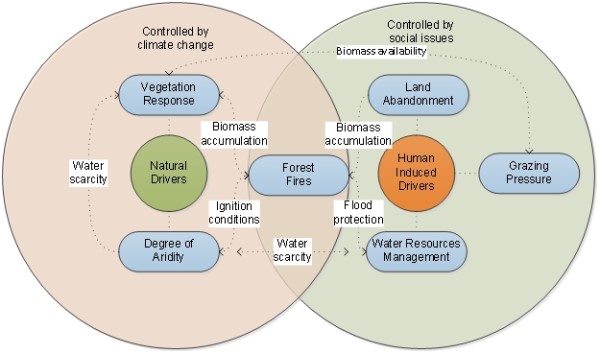Drivers of change in the study sites
| Authors: | Tsanis, I. K. and Daliakopoulos, I. N. |
| Editor: | Jane Brandt |
| Source document: | Daliakopoulos, I. and Tsanis, I. (eds) 2014. Drivers of change in the study sites. CASCADE Project Deliverable 2.2. CASCADE Report 06. 59 pp. |
As part of the natural environment, soil, much like water, forests, plants and animals is a global renewable resource, as long as it is adequately monitored, protected and conserved. Soil formation rates are so slow that the loss of its biological productivity or economic benefit leading to land degradation can be considered an irreversible process on human timescales. In most Mediterranean basin drylands, the downward spiral of land productivity that ends up in desertification is driven by population pressure. This pressure is often coupled with aridity that reduces the degree of soil development properties such as soil and infiltration depth, organic content and nutrients, thus hindering primary production and ecosystem resilience. Furthermore, agricultural intensification is leading to contamination of soils with nitrates, pesticides, and even heavy metals, while also endangering the quality and quantity of the often scarce water resources. Future conditions will most likely aggravate, as warming trends and natural climate variability render the Mediterranean a hotspot of climate change. Finally, a long term shortage of financial resources and institutions, which are critical for arresting or avoiding this spiral, augment the adverse conditions.
While, at first glance, the main drivers of degradation for each of CASCADE’s Study Sites are different, they are always relevant to the accumulated impact of a pressure: forest fires, marginal agriculture, grazing and wood-gathering activities, and long-term poor land management that is difficult to overturn. Less often, the causes of degradation are related to natural drivers such as climate, which nevertheless serves as a stimulant for all processes. Based on these outcomes, in natural and semi-natural ecosystems a distinction between two centers of influence can be made, either natural or human induced. The former include vegetation (or more broadly ecosystem) behavior and aridity, while the later encompasses land management issues such as abandonment, grazing pressure and offsite water resources management. While there is a large degree of interaction among drivers, forest fires are maybe the most bipolar driver of degradation. More importantly though, all drivers are enhanced or discouraged by climate variability (or change) on one hand, and social issues (i.e. demography, poverty and social inequality, lack of education and policy) on the other.

The »Natural and human induced drivers are further analyzed using the »Methodology described. Their accumulated impact can be associated with the concept of sudden ecosystem shifts beyond thresholds that preclude successful restoration of the desirable ecosystem properties and services. These thresholds can either depict a "point of no return" or a "resilience against restoration" owing to constrains due to lack of resources or unfavorable environmental conditions. Whereas for continuous pressure, thresholds may be sought in the combined effect of a secondary pressure, in the case of discontinuous events, thresholds relevant to event frequency and intensity are possible key indicators. Even though these thresholds are often associated with target species physiology, landscape and climatic characteristics and can be expected to have a localized effectiveness, emerging patterns can be organized into a »Unifying framework into which the instability observed in these Mediterranean ecosystems can be fitted.
Against the background of »Current and future climate trends for Mediterranean Europe we also further identify and quantify (to the extent possible) the natural and human induced drivers present in the CASCADE Study Sites.
»Várzea, Portugal
»Albatera, Spain
»Ayora, Spain
»Castelsaraceno, Italy
»Messara, Greece
»Randi Forest, Cyprus
Finally, in »Highlight conclusions it is shown that climate is a governing driver for all Study Sites and land use, land cover, production, consumption and disposal drive the relationship between social and ecological systems.
Related articles
